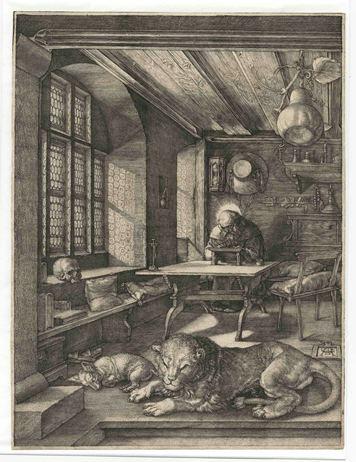The foremost artistic personality of the German Renaissance, Albrecht Dürer was an accomplished painter, printmaker, draftsman, and art theorist. His pictorial innovation and technical bravura transformed the arts of woodcut and engraving, elevating their status to transcend their craft origins and setting standards rarely matched in the history of printmaking. Three works dating to 1513–14 are singled out as the crowning achievements of Dürer’s illustrious career as an engraver: Knight, Death and the Devil; Melencolia I; and Saint Jerome in His Study. Closely related in size and complexity of execution, these three prints are known as Dürer’s Meisterstiche—or Master Engravings.

Albrecht Dürer, Saint Jerome in His Study, 1514, gift of the 2012 Collectors Committee, with additional funds provided by the Prints and Drawings Council and Philippa Calnan
Saint Jerome in His Study evokes an ideal of scholarly and spiritual reflection. Set in the ordered interior of a monastic cell, the learned saint is seen at his writing table. The lion, Jerome’s legendary companion, and the dog blissfully adrift at his feet, contribute an undeniably sympathetic appeal to the tranquil scene. The light-infused setting, cast in a carefully rendered perspective, has been greatly admired by artists, scholars, and collectors, since the sixteenth century. In his 1568 Lives of the Artists, Giorgio Vasari praised the depiction of sun streaming through the bull’s-eye glass windows as having “an effect so natural, it is a marvel,” furthermore claiming that “nothing more and nothing better could be done in this field of art.” Indeed, in its virtuoso handling of light and meticulous description of textures, Saint Jerome in his Study is a demonstration of Dürer’s supreme mastery of the pictorial possibilities of the engraving medium. This beautiful, rich impression of Saint Jerome in His Study, expertly printed with subtle areas of surface tone, is among the earliest taken from the plate. The careful attention given to the selection of papers and preparation of inks for his engravings strongly suggests Dürer printed his own plates. The artist issued his engravings in limited numbers in response to demand, and as a consequence a qualitative difference can be discerned between various printings. Later impressions can be distinguished from the earliest ones by the progressive dulling of lines and accumulation of scratches in the plate. Here, even the finest and most delicate lines print sharply, rendering a tonal range extending from soft silver to brilliant black to express the play of shimmering light in its most refined nuances. This sheet is also remarkable for its pristine condition. Its survival through five hundred years guarded from even minimal creases, tears, or stains is testament to the high regard in which it was held by its successive owners. LACMA’s holdings of Dürer’s prints constitute one of the greatest strengths of the Old Master works on paper collection. The collection includes beautiful, early exemplars of Dürer’s masterpieces of engraving, including Knight, Death and the Devil and Melencolia I, in addition to other important works as Adam and Eve and Saint Eustace. With the acquisition of this exquisite impression of Saint Jerome in his Study, LACMA now boasts the complete Master Engravings. Naoko Takahatake, assistant curator, Prints and Drawings



